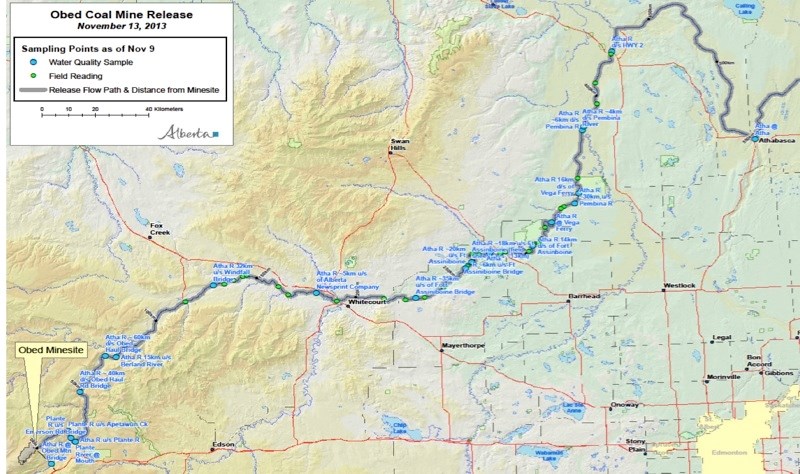The Alberta government is maintaining the Athabasca River's water is safe, despite the fact that some water quality guidelines were exceeded as far as 40 kilometres downstream from the source of a coal mine slurry spill near Hinton, data released tod
The Alberta government is maintaining the Athabasca River's water is safe, despite the fact that some water quality guidelines were exceeded as far as 40 kilometres downstream from the source of a coal mine slurry spill near Hinton, data released today show.
"I am confident that at no time was there a risk to the public's drinking water," said Dr. James Talbot, Alberta's chief medical officer of health, in a press release. "While there was a temporary increase in some contaminants, those levels are returning to normal."
The government has published a preliminary report and raw data from tests of the plume of coal mine slurry that has been making its way up the Athabasca River for more than two weeks. The 150-kilometre slurry plume is 114 kilometres upstream of Fort McMurray as of today, confirmed a representative from Sherritt International, which owns the coal mine where the spill originated.
The information indicates that the Town of Athabasca will be a site for ongoing monitoring of the river. While raw data from samples of the river where it passes the Town of Athabasca were released, the preliminary report and analysis show that at the time the samples were taken (Nov. 5), Athabasca was experiencing "pre-plume conditions." (The report is available at http://environment.alberta.ca/documents/obed_SummaryReport.pdf).
On Oct. 31, a holding pond at the decommissioned Obed Mountain Mine gave way, sending a billion litres of what Alberta Environment called "sediment" into two streams near Hinton and, eventually, the Athabasca River.
However, today's report states water samples "suggest the process water released by the spill contains elevated concentrations of many organic and inorganic contaminants" -the majority of which are bound to sediment particles in the slurry.
"This means that the removal of sediment in normal water treatment practices will very likely remove the majority of contaminants related to this spill and minimize risks to human health," the report states.
The report notes levels of contaminants are declining as the plume moves downstream; however, this does not mean the contaminants are disappearing.
"This decreasing trend likely results from sediments being deposited along the riverbed as the plume travels downstream," noted the report.
The preliminary data (available in spreadsheet form at http://alberta.ca/release.cfm?xID=3539774C6DBCD-A9D5-D0DE-96F3F3060C090544) show test results for 36 trace metals dissolved in water particles, total recoverable metals, and 27 polycyclic aromatic hydrocarbons (which can be cancer-causing).
The data were collected by Alberta Environment and Sustainable Resources (ESRD) and analyzed by both the ESRD and Alberta Health.
The government is still advising communities along the river not to draw water while the plume is passing.
The Aspen Regional Water Services Commission shut off its Athabasca River intake on Nov. 10.
See Tuesday's Athabasca Advocate for more in-depth coverage of this story.
